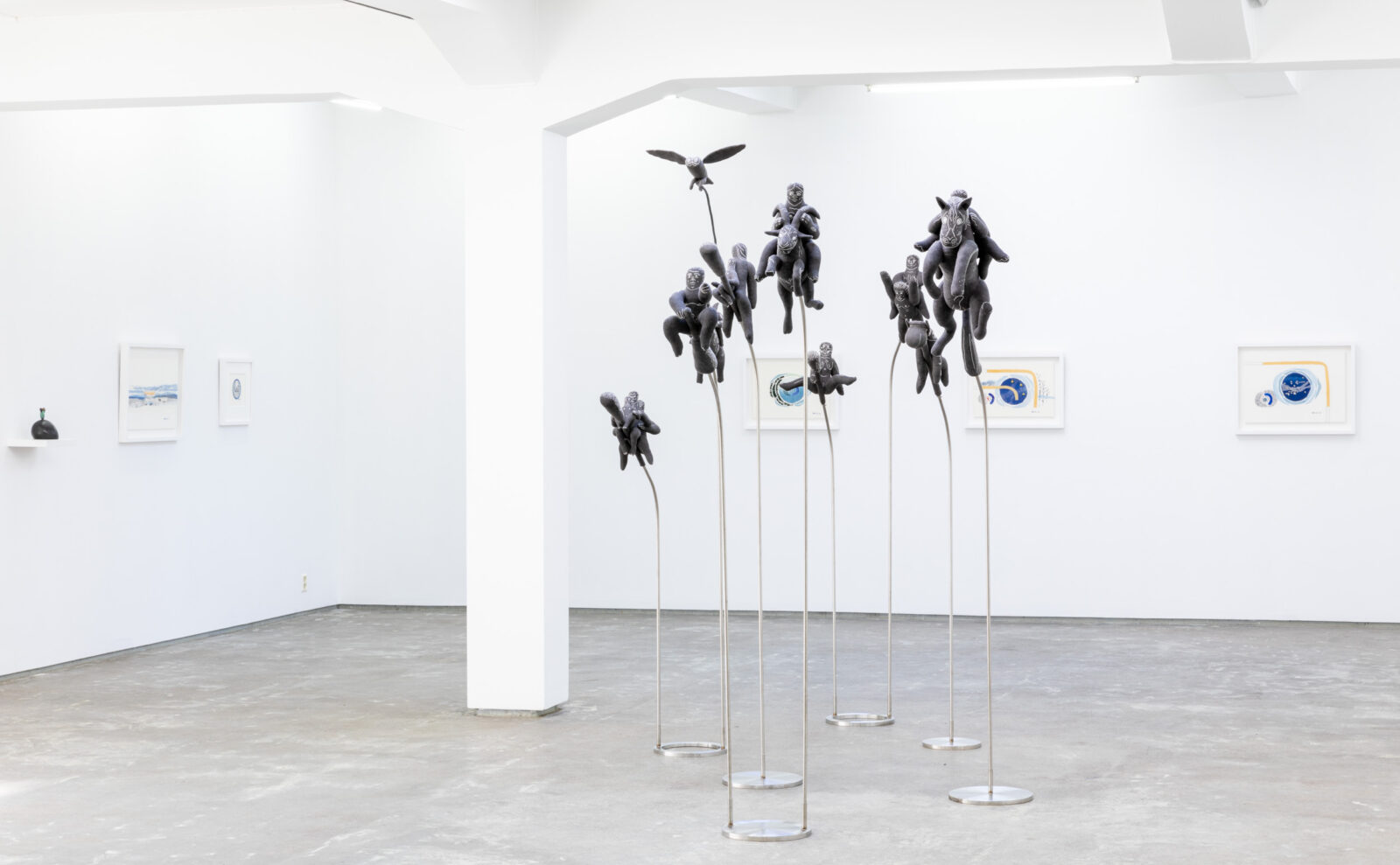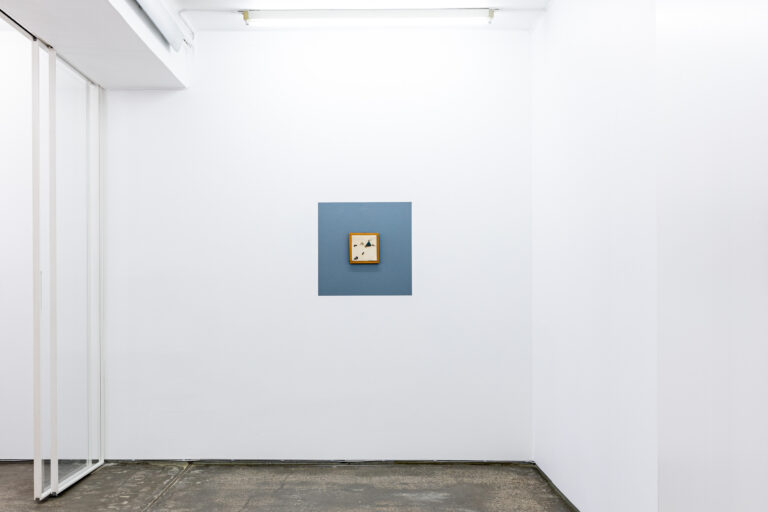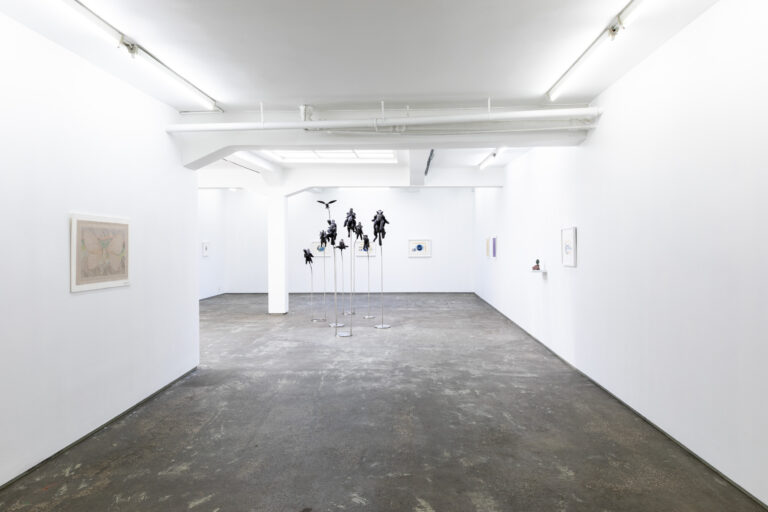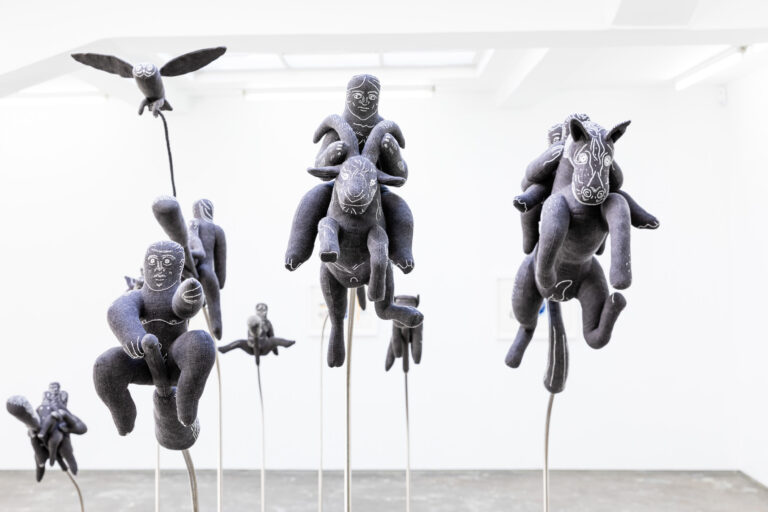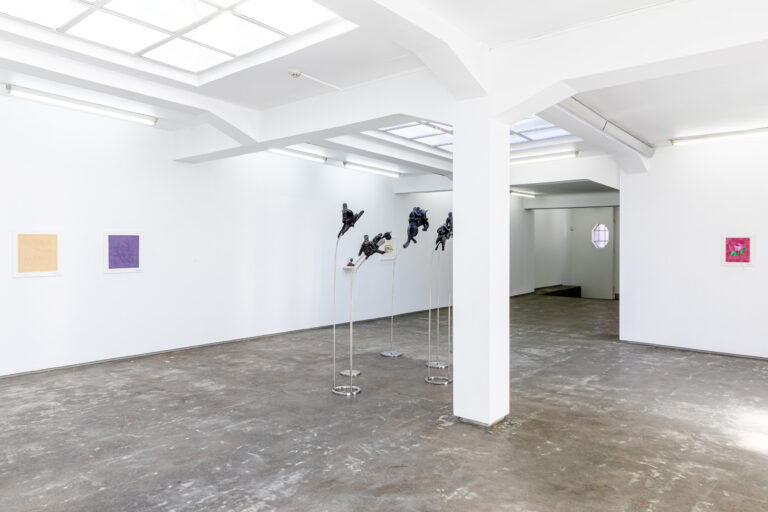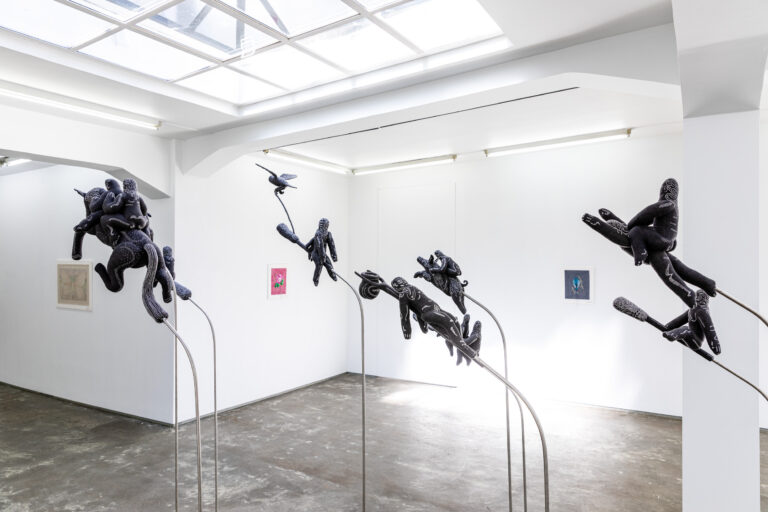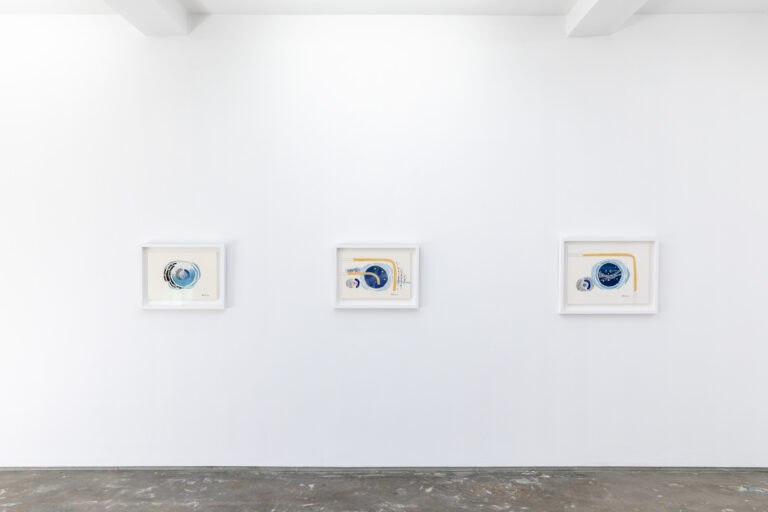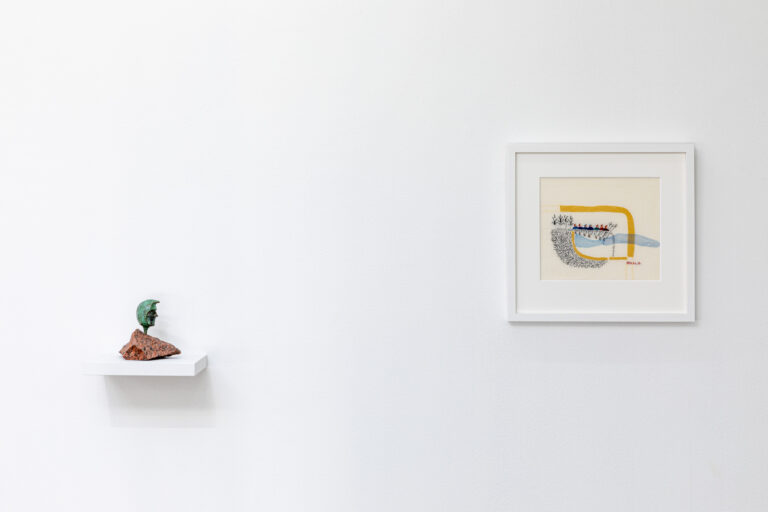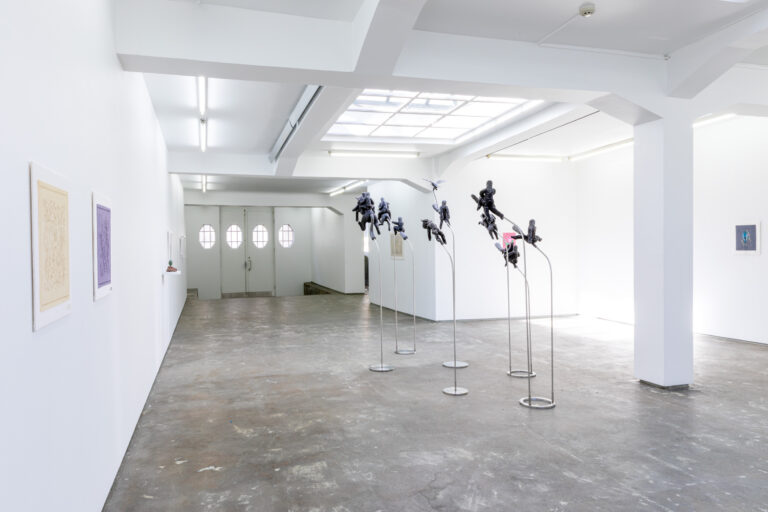Exhibition opening 20.04.2023, 18.00-20.00
It starts with a work, seen by the other. Although it also begins much before that.
Ask Bjørlo grew up with an embroidered work made by Britta Marakatt-Labba, exchanged for ceramics made by his mother in the early 1980s. It is also the work that largely inspired Bjørlo to work in the medium of textiles. As it happens in multiple instances, the work of an artist influences the practice of another and often interchangeably so. This relationship stands at the core of this two-person exhibition featuring embroideries and a sculpture by Bjørlo and embroideries, lithographs, serigraphs and sculptures by Marakatt-Labba. Although both with their own specific history and geography, Bjørlo and Marakatt-Labba’s practices coalesce in their mutual concerns dedicated to highlighting the climate emergency, fostering interspecies relationships and challenging the exploitation of power.
Sámi artist Marakatt-Labba depicts Sámi culture - an indigenous community stretching borderless across Northern Norway, Sweden, Finland and Russia - which is rooted in oral traditions by drawing on its mythology and history to represent the present. Born into a semi-nomadic reindeer herding community, Marakatt-Labba is known for her embroideries of colourful thread on white ground that depict various landscapes of Sápmi which are often populated by birch trees, stars, flowing water, reindeers and figures wearing traditional red horn shaped hats. A matriarchal society, Marakatt-Labba describes these figures as representing the souls of the primeval mothers that share their wisdom on the necessity to protect nature. The artist sculpturally transforms these embroidered figures into wood and bronze, such as with the work Urmodern. Through these sculptures, she pays homage to the Sámi women who wore the hats as a symbol of strength which, however, were banned when Christianity reached Sápmi in the 17th century as they were seen to convey the devil. Circular and oval motifs are present in myriad forms throughout her works as they are similarly present throughout Sámi culture, such as in the circular floor defined by the structure of the Kåta (temporary dwellings), in the oval shape of Sámi drums, as well as in the oval symbol that illustrates the Sámi sun deity. Marakatt-Labba has been actively dedicated to preserving Sámi culture against religious oppression, forced migration and integration, and abuse from state authorities for decades. This activism has seeped into her artistic practice through works such as the serigraph titled Kråkorna, made after the embroidery of the same name dated 1981. This work depicts a menacing swarm of crows gradually transforming into Norwegian police officers crashing with Sámi protesters at the Alta conflict. This protest that disputed the construction of the dam in the Alta river in Northern Norway, that would submerge ancient sacred Sámi relics, took place over the late 1970s and early 1980s. It is one of the many unjust and continual confiscations of Sámi land carried out by governments that are driven by the profit-oriented extraction of natural resources. This is exemplified by the current protest taking place, in which the Norwegian government has officially apologised for violating the human rights of the Sámi community for building wind farms on reindeer husbandry. Although a form of renewable energy, the Sámi community has successfully protested that this shift must not come at the expense of their livelihood. Through works that are guided by Sámi values and philosophy, Marakatt-Labba condemns Western anthropocentric hierarchies, demonstrating the significance of an interconnected relationship between nature and humans.
In this new sculptural work, Bjørlo departs from the 15th-18th century Nordic witch hunts to consider how systems of power reverberate into the present, including in the form of gendered violence, colonial oppression, and climate destruction. During this persecution, thousands were sentenced as witches charged with conspiring with the devil and deviantly carrying out witchcraft. Most of the accused were women, gay and indigenous people - marginalised individuals that operated outside of the hegemonic patriarchal institution and the dominant belief system. Used as scapegoats for causing hardships such as natural disasters and famine, these convictions were legally protected under the guise of maintaining social order. Bjørlo’s sculpture is composed of thirteen witches - the number of witches that would gather in a coven - riding to the sabbath in the night, scarcely lit by the beams of the moon as represented by the embroidered white thread on the black figures. The use of black and white visually alludes to the depiction of witches in 14th-18th century etchings, such as Albrecht Dürer’s The Witch, c. 1500 and Francisco Goya’s eighty prints and etchings titled Los caprichos, 1797-1798. They float in space; on brooms, others ride animals such as horses and goats, and one witch rides a bewitched human. This is a reference to the case of Anne Pedersdatter (d.1590), one of the most well known witch trials in Norway, who was accused of witchcraft on multiple occasions and among these was the accusation of having ridden her maid to a witch gathering. In the same way that Goya’s Los caprichos operated along satirical terms, Bjørlo ironically employs the demonised figure of the witch - deemed as personifications of evil - so as to redeem them into figures of positivity. A selection of embroideries stand in contrast - in terms of colour - to the witches, however, align in their condemnation of the dominance of one group over another. In this case, of human hubris over nature, calling instead for a symbiotic relationship between the two. Abstracted forms accompany more representational ones, such as a butterfly. The butterfly often symbolises transformation; in the process of shedding, the removal of the previous skin stands for a metaphor of freedom in which the constrictive past is released.
As traced by feminist theorist Silvia Federici, the witch hunts overlapped with the development of modern capitalism and the formation of spaces of enclosures (where discipline is enacted to ideologies and bodies). Where women’s bodies, in particular, were and continue to be characterised as corrupted, needing to be placed under the control of the state. In thinking through social reproduction, including that of nature, Federici calls for collective forms of reproduction as guided by the culture of indigenous peoples. In their unique methods and narratives, both Bjørlo and Marakatt-Labba suggest alternative structures to the presiding ones, that instead, rest on premises of care with a particular emphasis on the urgency of this for future generations.
- Exhibition text by Liv Cuniberti
Ask Bjørlo (b. 1992, Hønefoss, Norway) is an artist who specialises in traditional textile crafts, including weaving, embroidery, knitting, lacemaking and textile sculpture. Bjørlo takes a personal interest in textile history and has deep respect for its rich heritage. His work engages in dialogue with past traditions and practitioners, often from the queer perspective. Bjørlo draws inspiration from art history, nature, mythical creatures and childhood memories. For the artist, the works have an underlying message about human reference points, feelings and patience.
Bjørlo has an MA in material-based art from the Oslo National Academy of the Arts (KHiO, 2017–19). Before studying at KHiO he attended textile schools such as Nyckelviksskolan and Handarbetets Vänners Skola in Stockholm and Kawashima Textile School in Kyoto. He also studied textile science at Uppsala University. In 2017 he was included in the archive of 89plus on invitation by founders and co-curators Hans Ulrich Obrist and Simon Castets. Bjørlo’s works have been exhibited at Stavanger Kunstmuseum, Kunstnerforbundet in Oslo, Kunsthall Stavanger and Sandefjords kunstforening. As one of six artists, he was part of the project Studio reports (2020), where Bjørlo moved his large loom into the gallery space of Kunsthall Oslo. In the spring of 2021 Bjørlo held his first solo exhibition Tråd varsomt at OSL Contemporary. In 2022 he had the solo exhibition Spent Spekter at Soft Galleri and participated in the exhibition The Queer Gaze at KODE in Bergen. His works is included in collections such as Stavanger Art Museum; Oslo Municipality Art collection; KODE in Bergen; Kistefos Museum; and Nordea Art Collection.
Britta Marakatt-Labba (b. 1951) was born into a family of reindeer herders in Sápmi, one of the northernmost regions of the world and home to the Sámi Indigenous community. She is known for her embroidery work, for which she threads fine wool, silk, and linen onto white fabric grounds, as well as for prints, illustrations, scenic designs, and costumes produced for film and theatre. For over four decades, she has created motifs that often depict everyday life scenes and stories about Sami culture and the Nordic landscape. The themes in her works are strongly linked to her political reflections on ecology, climate, feminism and Sami identity, alternating between the historical and the present.
Marakatt-Labba has studied at Sunderby Folkehøgskole from 1971 to 1973 and at Konstindustriskolen in Gothenburg from 1974 to 1978, where she graduated with a bachelor’s degree in Textile Art. From 1999 to 2002, she studied at Sámi Allaskuvla in Kautokeino. After completing her studies, she became involved with other young Sami artists in building and forming the progressive artist collective Mázejoavku (Masi group) and the Sami Artists’ Association. She was also awarded an honorary doctorate in philosophy at the Faculty of Humanities at Umeå University in 2014.
She made her international breakthrough in 2017 when her embroidery piece ‘Historjá’ (2003–2007), also called the Tromsø frieze, a 23,5-meter long frieze that depicts motifs telling the history and mythology of the Sámi people. The work hung permanently in the Theory Sciences building at the University of Tromsø and was exhibited at documenta 14 in Kassel in 2017. Her works are included in the permanent collections of, among others, the Norwegian National Museum, Oslo; Röhsska museum, Gothenburg; Moderna Museet, Stockholm; and RiddoDuottarMuseat, Karasjok. In 2022, Marakkatt-Labba was part of The 59th International Art Exhibition of La Biennale di Venezia, titled ‘The Milk of Dreams’, curated by Cecilia Alemani. The same year saw the release of the film ‘HISTORJÁ’ - a documentary about Britta Marakatt-Labba’s work and life story.
Liv Cuniberti is a curator, writer and a current graduate at the Center for Curatorial Studies at Bard College in New York. Most recently, she has curated a solo exhibition of artist Sarah Rapson at the Hessel Museum of Art (NY) and is co-organising a performance of musician, rhythmanalyst, theorist, and writer DeForrest Brown Jr. at EMPAC (NY). She was part of the curatorial team for the exhibitions The 59th International Art Exhibition of La Biennale di Venezia (2022) and The Disquieted Muses: When La Biennale di Venezia Meets History (2020). Her independent research is focused on feminist theory and practices. She holds a BA in History of Art from The Courtauld Institute of Art in London.
